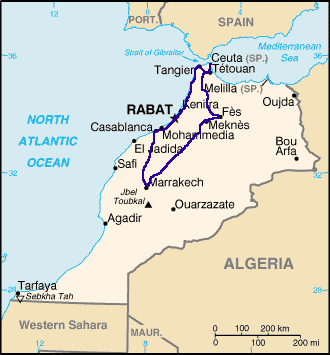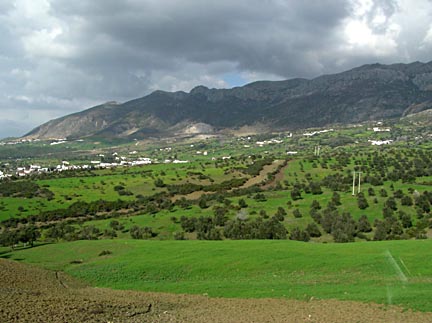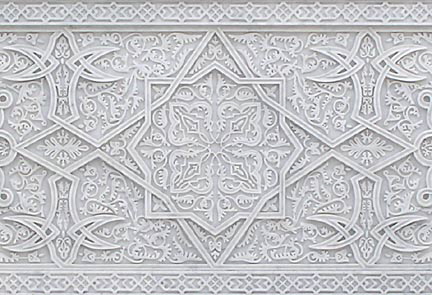 |
||
|
At one time, Morocco was divided into the holdings of the Spanish and those of the French. The French portion became independent, and in 1975 when Franco died, Spanish Morocco became independent. Tangier had been an international zone, controlled collectively by nine different countries from 1923 to 1957, so they could assure control of the Straits. The current ruler of Morocco is Mohammad VI, a young man in his 30’s, who has been rule now for about one and one-half years. His grandfather, Mohammad V, was the ruler who gained independence for Morocco, and is revered here. The first inhabitants of Morocco were the Berbers who came from Yemen. They still constitute approximately 45 percent of the population. From 500 B.C. to 159 A.D. the Romans occupied Morocco. The Berbers were free men and refused to be enslaved, so they escaped to the mountains and have been mountain dwellers ever since. You can see the women herding goats and sheep, dressed in their brightly striped skirts, each a different pattern to indicate her tribe, while the type of hat she wears tells whether she is single or married.
Islam is the religion of the country. Many things are forbidden by this religion such as drinking, but not forbidden by law. However multiple wives are allowed by the religion, although outlawed by the state. Unlike many Islam countries, the Moroccans are free to choose how they wish to live. The state does not enforce the tenets of the Islam religion, nor does it require one subscribe to that religion. Other churches are in evidence and religious harmony is enjoyed by all.
Click here for a slideshow of everyday life in Morocco. |
||
|
If you find typographical errors or have any other problems when looking at the site please contact the Webmaster describing the problem and the page involved. |
||
|
Copyright © 2000-2009 Jim Seavey and Verna Norris All Rights Reserved |
||
 Morocco sits at the northwestern corner of Africa, with its most northern point just 14 km from Spain, across the Straits of Gibralter. But however close to Europe it may be, it is a world apart from Europe. We first visited Tangier in 2000 on a day trip and again in 2001 on a second day trip. We returned for a longer tour in February 2006 to visit Fès, Meknès, Marrakech, Rabat, Casablanca and Tangier.
Morocco sits at the northwestern corner of Africa, with its most northern point just 14 km from Spain, across the Straits of Gibralter. But however close to Europe it may be, it is a world apart from Europe. We first visited Tangier in 2000 on a day trip and again in 2001 on a second day trip. We returned for a longer tour in February 2006 to visit Fès, Meknès, Marrakech, Rabat, Casablanca and Tangier. The lush greenness of northern Morocco was noticed by all of us, and our guide indicated that the fertile land of Morocco extends down to the Atlas Mountains, which separate green Morocco from the Sahara. It is a country of mountains, coastline—the longest of all of Africa—of lush plants, the desert, and of over 300 days of sunshine. There is no water shortage in Morocco as they have a good rainfall season. They boast over 100 dams for the country’s water usage, including generating electricity. They grow a wide variety of fruits and vegetables, and have an abundant fish crop. They are the world’s largest producer of sardines, and the fifth largest producer of olives and olive oil. The transformer for charging Jim’s mobile phone was made in Morocco.
The lush greenness of northern Morocco was noticed by all of us, and our guide indicated that the fertile land of Morocco extends down to the Atlas Mountains, which separate green Morocco from the Sahara. It is a country of mountains, coastline—the longest of all of Africa—of lush plants, the desert, and of over 300 days of sunshine. There is no water shortage in Morocco as they have a good rainfall season. They boast over 100 dams for the country’s water usage, including generating electricity. They grow a wide variety of fruits and vegetables, and have an abundant fish crop. They are the world’s largest producer of sardines, and the fifth largest producer of olives and olive oil. The transformer for charging Jim’s mobile phone was made in Morocco. On our tour in 2006, we briefly stopped in Rabat, the modern capital of Morocco. The highlight of our brief visit was the Mausoleum of Mohammed V. This is one of the few religious sites open to non-Muslims. The mausoleum is a stunning example of artisanship as we found the workmanship here to be the finest we have seen. The attention to detail and the quality of the materials used was phenomenal. The photo above is one example of the beautifully carved marble.
On our tour in 2006, we briefly stopped in Rabat, the modern capital of Morocco. The highlight of our brief visit was the Mausoleum of Mohammed V. This is one of the few religious sites open to non-Muslims. The mausoleum is a stunning example of artisanship as we found the workmanship here to be the finest we have seen. The attention to detail and the quality of the materials used was phenomenal. The photo above is one example of the beautifully carved marble.